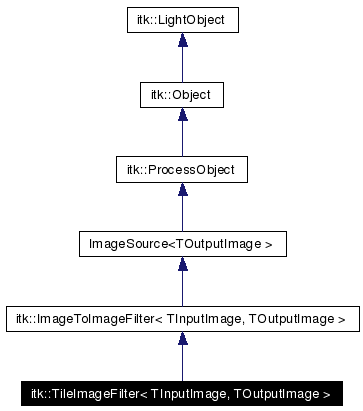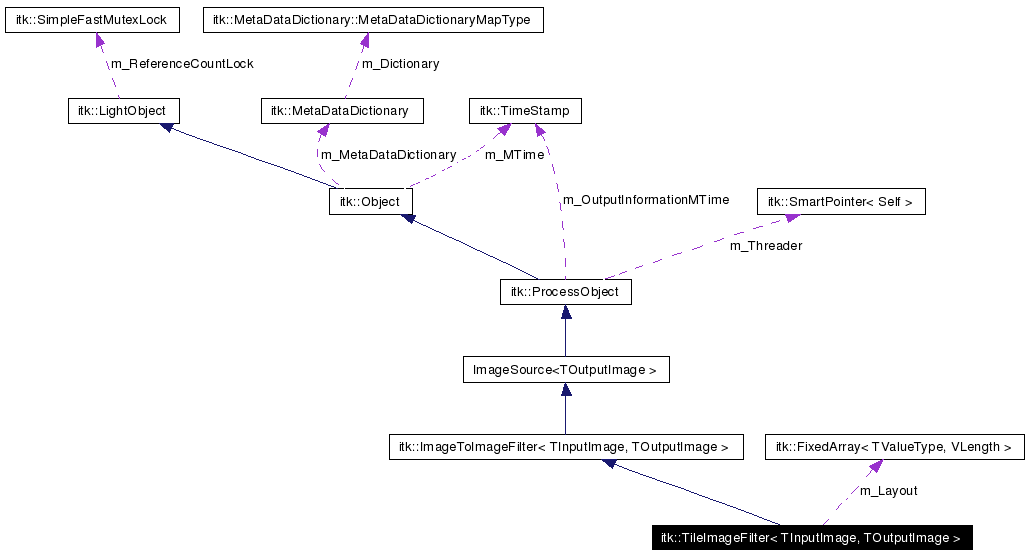
#include <itkTileImageFilter.h>
Inheritance diagram for itk::TileImageFilter< TInputImage, TOutputImage >:


Public Types | |
| typedef TileImageFilter | Self |
| typedef ImageToImageFilter< TInputImage, TOutputImage > | Superclass |
| typedef SmartPointer< Self > | Pointer |
| typedef SmartPointer< const Self > | ConstPointer |
| typedef TInputImage::PixelType | InputPixelType |
| typedef TOutputImage::PixelType | OutputPixelType |
| typedef TInputImage::Pointer | InputImagePointer |
| typedef TOutputImage::Pointer | OutputImagePointer |
| typedef TInputImage::SizeType | InputSizeType |
| typedef TInputImage::IndexType | InputIndexType |
| typedef TInputImage::RegionType | InputImageRegionType |
| typedef TOutputImage::SizeType | OutputSizeType |
| typedef TOutputImage::IndexType | OutputIndexType |
| typedef TOutputImage::RegionType | OutputImageRegionType |
| typedef Image< TileInfo, itkGetStaticConstMacro(OutputImageDimension) | TileImageType ) |
| typedef FixedArray< unsigned int, itkGetStaticConstMacro(OutputImageDimension) | LayoutArrayType ) |
Public Member Functions | |
| virtual const char * | GetNameOfClass () const |
| virtual void | SetDefaultPixelValue (OutputPixelType _arg) |
| virtual OutputPixelType | GetDefaultPixelValue () |
| itkStaticConstMacro (InputImageDimension, unsigned int, TInputImage::ImageDimension) | |
| itkStaticConstMacro (OutputImageDimension, unsigned int, TOutputImage::ImageDimension) | |
| virtual void | SetLayout (LayoutArrayType _arg) |
| virtual LayoutArrayType | GetLayout () |
Static Public Member Functions | |
| Pointer | New () |
Protected Member Functions | |
| TileImageFilter () | |
| ~TileImageFilter () | |
| void | PrintSelf (std::ostream &os, Indent indent) const |
| void | GenerateInputRequestedRegion () |
| void | GenerateOutputInformation () |
| void | GenerateData () |
This filter will tile multiple images using a user-specified layout. The tile sizes will be large enough to accommodate the largest image for each tile. The layout is specified with the SetLayout method. The layout has the same dimension as the output image. If all entries of the layout are positive, the tiled output will contain the exact number of tiles. If the layout contains a 0 in the last dimension, the filter will compute a size that will accommodate all of the images. Empty tiles are filled with the value specified with the SetDefault value method. The input images must have a dimension less than or equal to the output image. The output image have a larger dimension than the input images. This filter can be used to create a volume from a series of inputs by specifying a layout of 1,1,0.
Definition at line 44 of file itkTileImageFilter.h.
|
|||||
|
Reimplemented from itk::ImageToImageFilter< TInputImage, TOutputImage >. Definition at line 52 of file itkTileImageFilter.h. |
|
|||||
|
Image related typedefs. Reimplemented from itk::ImageToImageFilter< TInputImage, TOutputImage >. Definition at line 65 of file itkTileImageFilter.h. |
|
|||||
|
Reimplemented from itk::ImageToImageFilter< TInputImage, TOutputImage >. Definition at line 70 of file itkTileImageFilter.h. |
|
|||||
|
Definition at line 69 of file itkTileImageFilter.h. |
|
|||||
|
Image pixel value typedef. Definition at line 61 of file itkTileImageFilter.h. |
|
|||||
|
Definition at line 68 of file itkTileImageFilter.h. |
|
|||||
|
LayoutArray type. Definition at line 93 of file itkTileImageFilter.h. Referenced by itk::TileImageFilter< TInputImage, TOutputImage >::~TileImageFilter(). |
|
|||||
|
Reimplemented from itk::ImageSource< TOutputImage >. Definition at line 66 of file itkTileImageFilter.h. |
|
|||||
|
Superclass typedefs. Reimplemented from itk::ImageToImageFilter< TInputImage, TOutputImage >. Definition at line 73 of file itkTileImageFilter.h. |
|
|||||
|
Definition at line 72 of file itkTileImageFilter.h. |
|
|||||
|
Definition at line 62 of file itkTileImageFilter.h. Referenced by itk::TileImageFilter< TInputImage, TOutputImage >::~TileImageFilter(). |
|
|||||
|
Definition at line 71 of file itkTileImageFilter.h. |
|
|||||
|
Reimplemented from itk::ImageToImageFilter< TInputImage, TOutputImage >. Definition at line 51 of file itkTileImageFilter.h. |
|
|||||
|
Standard Self typedef Reimplemented from itk::ImageToImageFilter< TInputImage, TOutputImage >. Definition at line 49 of file itkTileImageFilter.h. Referenced by itk::TileImageFilter< TInputImage, TOutputImage >::~TileImageFilter(). |
|
|||||
|
Reimplemented from itk::ImageToImageFilter< TInputImage, TOutputImage >. Definition at line 50 of file itkTileImageFilter.h. |
|
|||||
|
Definition at line 90 of file itkTileImageFilter.h. |
|
|||||||||
|
|
|
|||||||||
|
|||||||||
|
A version of GenerateData() specific for image processing filters. This implementation will split the processing across multiple threads. The buffer is allocated by this method. Then the BeforeThreadedGenerateData() method is called (if provided). Then, a series of threads are spawned each calling ThreadedGenerateData(). After all the threads have completed processing, the AfterThreadedGenerateData() method is called (if provided). If an image processing filter cannot be threaded, the filter should provide an implementation of GenerateData(). That implementation is responsible for allocating the output buffer. If a filter an be threaded, it should NOT provide a GenerateData() method but should provide a ThreadedGenerateData() instead.
Reimplemented from itk::ImageSource< TOutputImage >. |
|
|||||||||
|
What is the input requested region that is required to produce the output requested region? The base assumption for image processing filters is that the input requested region can be set to match the output requested region. If a filter requires more input (for instance a filter that uses neighborhoods needs more input than output to avoid introducing artificial boundary conditions) or less input (for instance a magnify filter) will have to override this method. In doing so, it should call its superclass' implementation as its first step. Note that imaging filters operate differently than the classes to this point in the class hierachy. Up till now, the base assumption has been that the largest possible region will be requested of the input. This implementation of GenerateInputRequestedRegion() only processes the inputs that are a subclass of the ImageBase<InputImageDimension>. If an input is another type of DataObject (including an Image of a different dimension), they are skipped by this method. The subclasses of ImageToImageFilter are responsible for providing an implementation of GenerateInputRequestedRegion() when there are multiple inputs of different types.
Reimplemented from itk::ImageToImageFilter< TInputImage, TOutputImage >. |
|
|||||||||
|
Generate the information decribing the output data. The default implementation of this method will copy information from the input to the output. A filter may override this method if its output will have different information than its input. For instance, a filter that shrinks an image will need to provide an implementation for this method that changes the spacing of the pixels. Such filters should call their superclass' implementation of this method prior to changing the information values they need (i.e. GenerateOutputInformation() should call Superclass::GenerateOutputInformation() prior to changing the information. Reimplemented from itk::ProcessObject. |
|
|||||||||
|
Get the pixel value for locations that are not covered by an input image. |
|
|||||||||
|
Set/Get the layout of the tiles. If the last Layout value is 0, the filter will compute a value that will acoomodate all of the images. |
|
|||||||||
|
Runtime information support. Reimplemented from itk::ImageToImageFilter< TInputImage, TOutputImage >. |
|
||||||||||||||||||||
|
Image related typedefs. Reimplemented from itk::ImageToImageFilter< TInputImage, TOutputImage >. |
|
||||||||||||||||||||
|
Image related typedefs. Reimplemented from itk::ImageToImageFilter< TInputImage, TOutputImage >. |
|
|||||||||
|
Method for creation through the object factory. Reimplemented from itk::Object. |
|
||||||||||||||||
|
Methods invoked by Print() to print information about the object including superclasses. Typically not called by the user (use Print() instead) but used in the hierarchical print process to combine the output of several classes. Reimplemented from itk::ImageToImageFilter< TInputImage, TOutputImage >. |
|
||||||||||
|
Set the pixel value for locations that are not covered by an input image. The default default pixel value is Zero. |
|
||||||||||
|
Set/Get the layout of the tiles. If the last Layout value is 0, the filter will compute a value that will acoomodate all of the images. |
 1.3.5 written by Dimitri van Heesch,
© 1997-2000
1.3.5 written by Dimitri van Heesch,
© 1997-2000